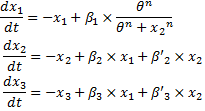Team:Paris/Modeling/BOB/Akaike
From 2008.igem.org
(Difference between revisions)
(→Experiment) |
|||
| Line 24: | Line 24: | ||
{| | {| | ||
|- style="background: #649CD7;" | |- style="background: #649CD7;" | ||
| - | ! colspan="3" style="background: #649CD7;" | Comparison of the systems | + | ! colspan="3" style="background: #649CD7;" | Comparison of the systems for n=20 |
|- style="background: #649CD7; text-align: center;" | |- style="background: #649CD7; text-align: center;" | ||
| Criteria | | Criteria | ||
| Line 43: | Line 43: | ||
|} | |} | ||
| + | |||
| + | {| | ||
| + | |- style="background: #649CD7;" | ||
| + | ! colspan="3" style="background: #649CD7;" | Comparison of the systems for n=100 | ||
| + | |- style="background: #649CD7; text-align: center;" | ||
| + | | Criteria | ||
| + | | System#1 | ||
| + | | System#2 | ||
| + | |- style="background: #dddddd;" | ||
| + | | style="background: #D4E2EF;" | AIC | ||
| + | | 169.5495 | ||
| + | | 32.1150 | ||
| + | |- style="background: #dddddd;" | ||
| + | | style="background: #D4E2EF;"| AICc | ||
| + | | 171.1147 | ||
| + | | 38.5912 | ||
| + | |- style="background: #dddddd;" | ||
| + | | style="background: #D4E2EF;"| BIC | ||
| + | | 172.0100 | ||
| + | | 37.0360 | ||
| + | |||
| + | |} | ||
| + | |||
</center> | </center> | ||
* Consequently, what have we proved? These results show that: | * Consequently, what have we proved? These results show that: | ||
| - | ** | + | ** Firstly, we may see that the AICc does converge to AIC for greater values of n. |
| + | ** Then, we may see that, as predicted, System#2 is not more penalized for greater values of n, although System#1 is. | ||
| + | ** Furthermore, since the use of more parameters is quite penalizing for a small set of data, and since the criteria are minimized for System#1, the first subsystem of our BOB model is not irrelevant. | ||
| + | ** However, since for a larger set of data System#2 minimizes the criteria, these criteria cannot decide whether a model is better than another one, since those criteria are arbitrary. Yet, they may help us find a better compromise between simplification and accuracy. | ||
** One must be careful when building a model, since chosing the number of parameters and deciding how deep one wishes to go into detail, influences the goal and the results of a model. It is therefore important to understand that a model has to be conceived to achieve a precise aim. | ** One must be careful when building a model, since chosing the number of parameters and deciding how deep one wishes to go into detail, influences the goal and the results of a model. It is therefore important to understand that a model has to be conceived to achieve a precise aim. | ||
** Then, it is always useful to use different models, knowing that each model meets a certain demand. Here, our full model ([[Team:Paris/Modeling/APE|APE]]) will be used to present a highly detailed overview of the processes that take place in the system. In the mean time, the [[team:Paris/Modeling/BOB|BOB]] approach is a reasonable mean to explore the system quickly. | ** Then, it is always useful to use different models, knowing that each model meets a certain demand. Here, our full model ([[Team:Paris/Modeling/APE|APE]]) will be used to present a highly detailed overview of the processes that take place in the system. In the mean time, the [[team:Paris/Modeling/BOB|BOB]] approach is a reasonable mean to explore the system quickly. | ||
Revision as of 13:51, 3 September 2008
|
What about the model?
Short introduction to the criteria
where n denotes the number of experimental values, k the number of parameters and RSS the residual sum of squares. The best fitting model is the one for which those criteria are minimized.
Experiment
System#1 : using the linear equations from our BOB approach : System#2 : using classical Hill functions :
We mostly used the definition of the criteria given in : [http://www.liebertonline.com/doi/pdf/10.1089/rej.2006.9.324 K. Kikkawa.Statistical issue of regression analysis on development of an age predictive equation. Rejuvenation research, Volume 9, n°2, 2006.] |
||||||||||||||||||||||||||||||
 "
"


